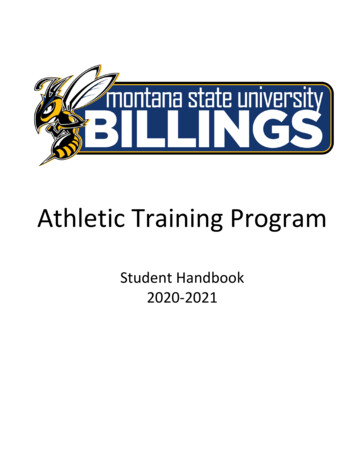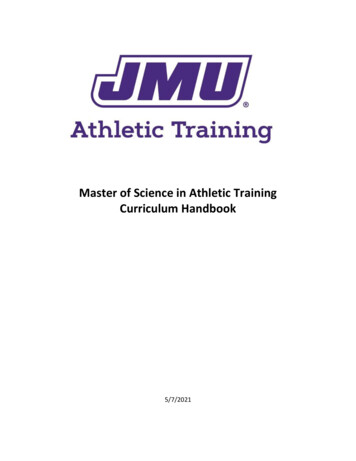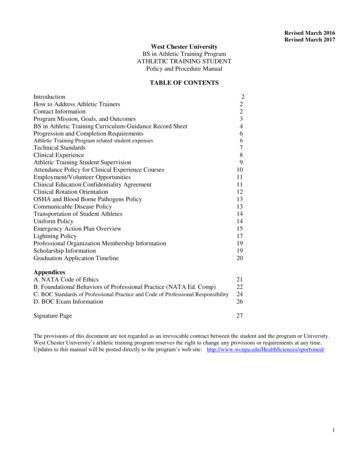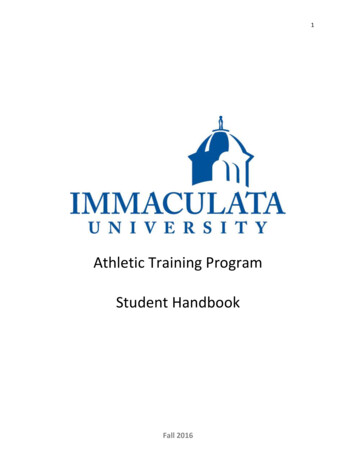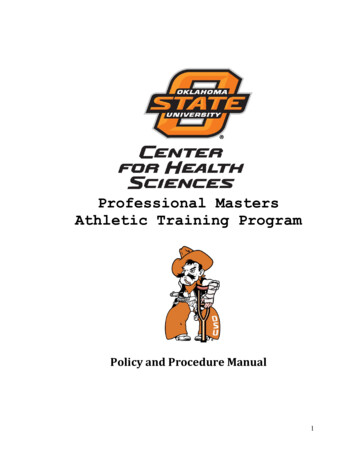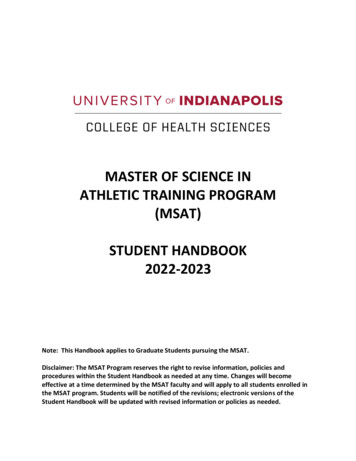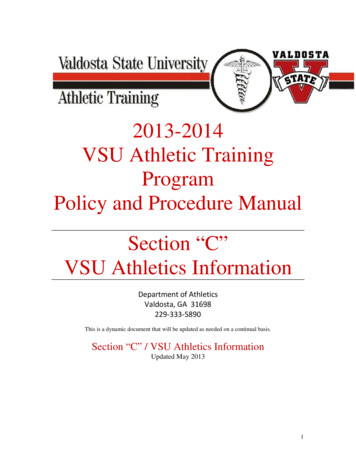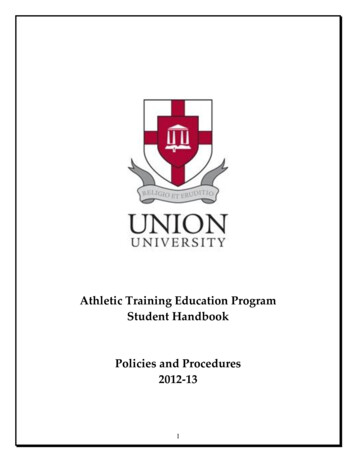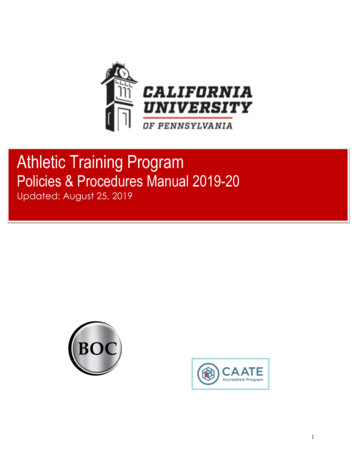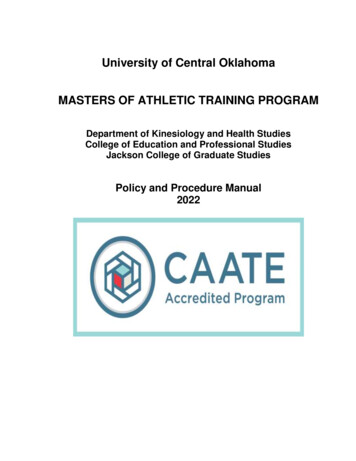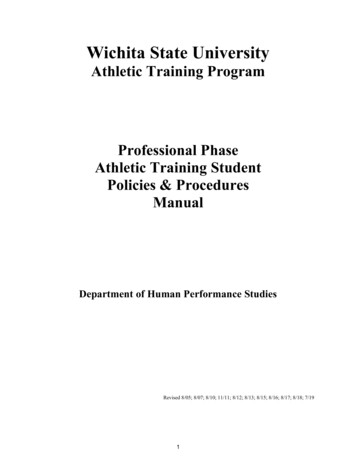
Transcription
Wichita State UniversityAthletic Training ProgramProfessional PhaseAthletic Training StudentPolicies & ProceduresManualDepartment of Human Performance StudiesRevised 8/05; 8/07; 8/10; 11/11; 8/12; 8/13; 8/15; 8/16; 8/17; 8/18; 7/191
Table of ContentsForward3Foundational Behaviors of Professional Practice4Mission Statement5Goals/Objectives5Clinical Education Policies7Clinical Expectations10Practicum Rubric14Applying for Graduation15Confidentiality Policy15Communicable Disease Policy15Dress Policy16Fair Practice Work Policy16Grievance Procedures17Probation and Dismissal17Retention18Scholarships18Student Interpersonal Relationships19Technology19Uncalibrated Equipment Policy19Weather Policy20Work Habits20ATS Travel Form21Evaluations22Equipment Intensive22Upper Extremity24Lower Extremity26General Medical28Transfer Student30Therapeutic Modalities32Rehabilitation34Agreement Statement362
ForwardAn athletic trainer is defined by the National Athletic Trainers’ Association (NATA), as aqualified allied healthcare professional that is educated and skilled in meeting the healthcareneeds of individuals involved in physical activity. The athletic trainer functions as an integralmember of the athletic health care team in secondary schools, colleges and universities sportsmedicine clinics, professional sports programs and other athletic health care settings. The athletichealthcare team includes: the athletic trainer, administrators, parents, athletes and athleticcoaches in the providing an efficient and responsive athletic health care delivery system. As amember of the complete health care team, the athletic trainer works under the direction of alicensed physician and in cooperation with other healthcare professionals.The Athletic Training Program (ATP) at Wichita State University takes great pride in the qualityof education it provides to students. Realizing that athletic training is such a diverse field,athletic training students are exposed to a variety of different learning experiences and teachingmethods. Classroom and clinical experience is gained in each of the following curriculum areasof athletic training:1.2.3.4.5.6.7.8.Evidence Based-PracticePrevention and Health PromotionClinical Examination and DiagnosisAcute Care of Injuries and IllnessesTherapeutic InterventionsPsychosocial Strategies and ReferralHealth Care AdministrationProfessional Development and ResponsibilityBy encouraging the athletic training students (ATS) to develop each of these areas, a wellrounded and competent practitioner will emerge from the program that will be able to adequatelynegotiate obstacles both on and off the field. In order to gain the clinical experience necessary toachieve Board of Certification (BOC) certification and a career in athletic training, it is importantthat the student become a working member in the athletic training facility. The BOC hasidentified the performance domains of the practicing athletic trainer to be:1.2.3.4.5.Injury Illness Prevention and Wellness ProtectionClinical Evaluation and DiagnosisImmediate and Emergency CareTreatment and RehabilitationOrganizational and professional Health and Well BeingThis manual is intended to aid in the orientation of the ATS as well as serve as a valuablereference tool during the pre-professional phase experience. Athletic training is a profession thatcommands a great deal of dedication and work without much credit. Prioritization ofextracurricular activities is a necessary step to achieve success in the athletic training facility andin the classroom. The clinical experience begins during the first week of school in August andends around mid-May with finals. Holiday breaks for athletic trainers are unlike those of theaverage person. Clinical time accrued during holiday breaks outside the academic calendar isleft up to the student; however, these hours do not count toward any course, practicum, orinternship credit.3
Foundational Behaviors of Professional PracticeThese basic behaviors permeate professional practice and should be incorporated intoinstruction and assessed throughout the educational program. Recognize sources of conflict of interest that can impact theclient’s/patient’s health.Primacy of Know and apply the commonly accepted standards for patientthe Patientconfidentiality. Provide the best healthcare available for the client/patient. Advocate for the needs of the client/patient. Recognize the unique skills and abilities of other healthcare professionals. Understand the scope of practice of other healthcare professionals.Team Execute duties within the identified scope of practice for athletic trainers.Approach to Include the patient (and family, where appropriate) in the decision-makingPracticeprocess. Work with others in effecting positive patient outcomes. Practice athletic training in a legally competent manner.Legal Identify and conform to the laws that govern athletic training.Practice Understand the consequences of violating the laws that govern athletictraining. Comply with the NATA’s Code of Ethics and the BOC’s Standards ofProfessional Practice.Ethical Understand the consequences of violating the NATA’s Code of Ethics andPracticeBOC’s Standards of Professional Practice. Comply with other codes of ethics, as applicable. Critically examine the body of knowledge in athletic training and relatedfields. Use evidence-based practice as a foundation for the delivery of care. Appreciate the connection between continuing education and theAdvancingimprovement of athletic training practice.Knowledge Promote the value of research and scholarship in athletic training. Disseminate new knowledge in athletic training to fellow athletic trainers,clients/patients, other healthcare professionals, and others as necessary. Demonstrate awareness of the impact that clients’/patients’ culturaldifferences have on their attitudes and behaviors toward healthcare.Cultural Demonstrate knowledge, attitudes, behaviors, and skills necessary toCompetenceachieve optimal health outcomes for diverse patient populations. Work respectfully and effectively with diverse populations and in adiverse work environment. Advocate for the profession.Professionalism Demonstrate honesty and integrity. Exhibit compassion and empathy. Demonstrate effective interpersonal communication skills.4
Mission StatementThe mission of the ATP is to provide a comprehensive program of academic coursework andfield experience that will educate athletic training students for entry-level positions in theprofession of athletic training. The ATP strives to meet the standards, educationalcompetencies, and clinical proficiencies for athletic training education through professionalservice, research activities, and curriculum design. The ATP abides by the policies andprocedures as set forth by the Commission on Accreditation of Athletic Training Education(CAATE), National Athletic Trainers’ Association (NATA), BOC, and the Kansas Board ofHealing Arts.Goals and Objectives of the ATPStandard 1. Students will demonstrate an understanding of evidence-based practiceconcepts and their application to essential clinical decision-making and critical examinationof athletic training practice.Objectives:A. Demonstrate an understanding of evidence-based practice through oral and visualexamination of competency testing on skill sheets.B. Demonstrate an understanding of evidence-based practice through written examination.C. Demonstrate an understanding of evidence-based practice through current literaturereview on case study projects and presentation.Standard 2: Students will develop and implement strategies and programs to prevent theincidence and/or severity of injuries and optimize their clients/patients overall health andquality of life. (Prevention and Health Promotion).Objectives:A. Demonstrate an understanding of prevention and health promotion through oral andvisual examination of competency testing on skill sheets.B. Demonstrate an understanding of prevention and health promotion through writtenexamination.C. Demonstrate an understanding of prevention and health promotion through currentliterature review on case study projects and presentation.Standard 3. Students will demonstrate the ability to possess strong clinical examinationskills in order to accurately diagnosis and effectively treat their patients. (ClinicalDiagnosis and Evaluation)Objectives:A. Demonstrate an understanding of clinical examination and diagnosis through oralexamination of competency testing on skill sheets.B. Demonstrate an understanding of clinical examination and diagnosis through written andpractical examinations.5
C. Demonstrate an understanding of clinical examination and diagnosis through currentliterature review on case study projects and presentation.Standard 4: Students will demonstrate knowledge and skills in the evaluation andimmediate management of acute injuries and illnesses. (Acute Care of Injuries andIllnesses).Objectives:A. Demonstrate an understanding of acute care of injuries and illnesses through oral andvisual examination of competency testing on skill sheets.B. Demonstrate an understanding of acute care of injuries and illnesses through writtenexamination.C. Demonstrate an understanding of acute care of injuries and illnesses through currentliterature review on case study projects and presentation.Standard 5. Students will demonstrate the ability to assess the patient’s status usingclinician-and patient-oriented outcome measures to determine the stage of healing, goals,and therapeutic intervention to maximize the patient’s participation and health-relatedquality of life. (Therapeutic Interventions)Objectives:A. Demonstrate an understanding of therapeutic interventions through oral examination ofcompetency testing on skills sheets.B. Demonstrate an understanding of therapeutic interventions through written and practicalexaminations, quizzes, and homework assignments.C. Demonstrate an understanding of therapeutic interventions through current literaturereview on case study projects and presentation.Standard 6: Students will demonstrate the ability to recognize clients/patients exhibitingabnormal social, emotional, and mental behaviors. (Psychosocial Strategies and Referral).Objectives:A. Demonstrate an understanding of psychological strategies and referral through oralexamination of competency testing on skills sheets.B. Demonstrate an understanding of psychological strategies and referral through writtenand practical examinations, quizzes, and homework assignments.C. Demonstrate an understanding of psychological strategies and referral through currentliterature review on case study projects and presentation.Standard 7: Students will demonstrate the ability to function within the context of acomplex healthcare system and understand risk management, healthcare deliverymechanisms, insurance, reimbursement, documentation, patient privacy, and facilitymanagement. (Healthcare Administration).Objectives:A. Demonstrate an understanding of healthcare administration through oral examination ofcompetency testing on skills sheets.B. Demonstrate an understanding of healthcare administration through written and practicalexaminations, quizzes, and homework assignments.6
C. Demonstrate an understanding of healthcare administration through current literaturereview on case study projects and presentation.Standard 8: Students will demonstrate the understanding maintaining competence inhealthcare, embrace the athletic training practice within the limits of state and nationalregulations using moral and ethical judgment, and work collaboratively with otherhealthcare providers. (Professional Development and Responsibility).Objectives:A. Demonstrate an understanding of professional development and responsibility throughoral examination of competency testing on skills sheets.B. Demonstrate an understanding of professional development and responsibility throughwritten and practical examinations, quizzes, and homework assignments.C. Demonstrate an understanding of professional development and responsibility throughcurrent literature review on case study projects and presentation.Standard 9: Students will demonstrate the clinical integration proficiencies that representthe synthesis and integrations of knowledge, skills, and clinical decision-making into actualclient/patient care. (Clinical Integration Proficiencies).Objectives:A. Demonstrate an understanding of clinical integration proficiencies through oralexamination of competency testing on skills sheets.B. Demonstrate an understanding of clinical integration proficiencies through currentliterature review on case study projects.Clinical Education PoliciesThe ATP has developed clinical education policies relating to the athletic training practicumrotations, clinical hour logs, supervision, and student evaluations. These polices apply to anyclinical education environment which the ATP has an affiliation agreement.A)Clinical Course (Athletic Training Practicum) Rotation:a. The clinical education field experiences provide the student with opportunity forinformal learning and practice of clinical proficiencies. Ample opportunities forsupervised experience working with athletic practice and competition are tailoredto meet specific goals and objectives.b. Clinical education is incorporated through athletic training practicums whichbegin in the second year of the program. These athletic training practicumsfollow a particular course that encompasses educational and psychomotorcompetencies as well as clinical proficiencies. Each practicum has detailedclinical objectives the student must meet for a portion of the course grade.Students must enroll and successfully complete the requirements for thepracticum before continuation in the clinical education portion of the program.c. Students are evaluated on four specific areas consisting of (1) evaluation ofskills, abilities, and professional attitude while serving as an athletic trainingstudent at the clinical site, (2) evaluation of the athletic training student's7
participation in practicum skill tests administered while meeting the class, (3) thecompletion of the required clinical work hours each week, (4) student'sparticipation in practicum class sessions and other content areas (See rubric forpracticums on page 14). The following is a description for each practicum:ATS Year:Level I(1 Year ATP)stLevel II(2nd Year ATP)Level III(3rd Year ATP)B)a.b.c.d.e.f.AT Practicum Courses Per Semester:Clinical Rotation Emphasis:FallHPS 220 – AT Practicum IEquipment IntensiveSpringHPS 221 – AT Practicum IIUpper Extremity EvaluationFallHPS 320 – AT Practicum IIILower Extremity EvaluationSpringHPS 321 – AT Practicum IVFallHPS 420 – AT Practicum VSpringHPS 421 – AT Practicum VITherapeutic Modalities & PhysicalTherapyGeneral Medical Conditions &RehabilitationAthletic Training Administration& BOC Certification PreparationClinical Hours and Log:Clinical hours must be registered in the clinical hour log daily and signed by thestudent’s Preceptor. The Preceptor is responsible to accurately monitor theregistering of student hours periodically (at least twice a month). It is the student’sresponsibility to register and tabulate hours for Preceptor verification. If the studentdoes not register hours, those missing must be made up for clinical educationrequirements.Level I-III athletic training students are to accumulate a minimum of 10 hours and amaximum of 60 hours in a week.Athletic training students are to have one day off per seven day period.Work hours must be considered appropriate for learning experiences; therefore deadtime hours are not to be accumulated. Examples: rain delays, time when team is infilm sessions, early training facility hours with no athletes, other situations as deemedby preceptor. Therefore, some weeks will have more and some will have lessdepending of the particular clinical site schedule. The student must continually planfor events, practices, and competition at their clinical site. The Preceptor will notifythe ATS of any changes to the schedule when it becomes available. ATS’s are notrequired to travel out of town during the clinical experience; therefore, release time isprovided during off days. ATS’s can travel when opportunities become availablebaring the fact that academic performance does not falter. Every effort should bemade to provide time off for academic performance. ATS’s are not given time off foroutside employment.Athletic training students are expected to be on-site daily. Students having a clinicalrotation on-campus who have afternoon classes are allowed to leave no more than 30minutes prior to class time. Students who have a clinical rotation off-campus canleave at a time determine by their preceptor; but are expected to be on-site the day ofclass.Athletic training students are not required to travel out of town during the clinicalexperience; therefore, release time is provided during off days. Athletic trainingstudents should plan for “off days” in accordance to the travel schedule for the team.Therefore, when the team is traveling, you are to have those days off from clinical8
C)D)time. Unless approved by your Preceptor, you are not to work/observe during “offtime”. Athletic training students with extended home schedules will be given extrarelease time (i.e. at least one day off per seven working days). Every effort is made toprovide extra time off for academic performance. There wil be NO extra time off foroutside employment.Clinical Supervision:a. Direct supervision applies to instruction and evaluation of clinical proficienciesby a Preceptor. Constant visual and auditory interaction between the studentand Preceptor must be maintained.b. Clinical supervision applies to the field experience under the direction ofPreceptor. Daily personal/verbal contact at the setting of supervision betweenthe student and Preceptor, who plans, directs, advises, and evaluates the student’sfield experience. The Preceptor shall be physically present to intervene onbehalf of the athlete/patent.Clinical Evaluation:a. The comprehensive assessment plan for the ATP evaluates a variety of issuesrelating to student skill acquisition, personal/professional attributes, and workperformance. These assessments provide the program and student with valuableinformation to appraise their overall performance. Each evaluation is kept onfile in the student’s portfolio in the Clinical Education Coordinator’s office. TheATP reviews the information and uses the evaluation tools to find anyweaknesses or strengths of the program.b. Students provide vital information about the effectiveness and efficiency of theprogram. Therefore, students will have ample opportunity to complete variousassessments about the academic program, Preceptor, Program Director, ClinicalEducation Coordinator, clinical sites, and clinical experience. An overview ofthis comprehensive assessment plan includes:1. Written student evaluations of individual courses and instructors.2. Written student evaluations of supervising Preceptor for each CAATErequired clinical rotation: equipment intensive, upper extremity, lowerextremity, and general medical.3. Written Preceptor evaluations of students each semester.4. Written student evaluations of clinical sites.5. Written graduating senior evaluation during the last semester in the ATP.6. Oral exit interviews with graduating seniors during the last semester in theATP.7. Written student evaluations of advising with the HPS Undergraduate MajorAdvisor regarding required coursework and degree requirements.8. Alumni evaluation regarding professional preparation at 1 year and 3 year.9. Employer evaluation within the first year of employment regardingprofessional preparation.9
Clinical Expectations:Students are expected to perform the designated competencies based upon their clinical rotation.These competencies are related to the prior semester’s course and laboratory components.Students are expected to bring study materials (i.e. text books.) and competencies sheets to theclinical rotation that correlates to the assigned competency. Students will have opportunities toreview competencies with their Preceptor during the week prior to obtaining Preceptor or courseinstructor formal approval. Once approved, students can perform the competency in the clinicalsetting with Preceptor supervision. The following is a list of clinical expectations for each level:Level I Athletic Training Student Clinical Expectations:Bracing, Taping, Padding,and Wrapping Skills:Level I ATSFall Semester:HPS 220 – ATPracticum ITaping, wrapping, and bracingtechniquesFabrication of protectivepaddingEquipment Fitting ProceduresCPR/AEDSpine Board/StabilizationCrutch Fitting & WalkingSplintingAcute Injury ManagementEnvironmental Illness (Heat/Cold& Lightening)Flexibility/StretchingFitness ExercisesTherapeutic Modality Application(ice and heat ONLY)Blood Borne C Protocol/PoisonControlPreviously Learned Skills:Upper Extremity Evaluation:Clinical RotationEmphasis:Equipment Intensive(Sports that useEquipment)Level I ATSSpring Semester:HPS 221 – ATPracticum IIEmergency Skills and RiskManagement:Bracing, Taping, Padding, andWrapping SkillsEmergency Skills and RiskManagementClinical RotationEmphasis:Upper ExtremityEvaluation10History inventory of injuryObservation of physicalsigns/symptomsPalpation of head, cervical spine,shoulder, elbow, wrist, and handanatomyPerform Active and Passive Rangeof MotionResistive Muscular TestingSpecial TestingFunctional Testing
Level II Athletic Training Student Clinical Expectations:Level II ATSFall Semester:HPS 320 – ATPracticum IIIPreviously Learned Skills:Bracing, Taping, Padding, andWrapping SkillsEmergency Skills and RiskManagementUpper Extremity EvaluationClinical RotationEmphasis:Lower ExtremityEvaluationLevel II ATSSpring Semester:HPS 321 – ATPracticum IVClinical RotationEmphasis:TherapeuticModalities &Physical TherapyLower Extremity Evaluation:History inventory of injuryObservation of physicalsigns/symptomsPalpation of head, cervical spine,shoulder, elbow, wrist, and handanatomyPerform Active and Passive Rangeof MotionResistive Muscular TestingSpecial TestingFunctional TestingPreviously Learned Skills:Therapeutic Modality Application:Bracing, Taping, Padding, andWrapping SkillsEmergency Skills and RiskManagementUpper Extremity EvaluationLower Extremity EvaluationUltrasoundElectrical StimulationIontophoresisIntermittent Compression (elasticwrap, cryo-cuff, etc .)Massage TechniquesJoint MobilizationsTraction (Mechanical, Positional, andManual)11
Level III Athletic Training Student Clinical Expectations:Previously Learned Skills:Rehabilitation:Bracing, Taping, Padding, andWrapping SkillsEmergency Skills and RiskManagementUpper Extremity EvaluationLower Extremity EvaluationTherapeutic ModalityApplicationProgram design and protocolExercise techniquesAquatic therapyRehabilitation of the UpperExtremityRehabilitation of the LowerExtremityRehabilitation of the Spine and TrunkGeneral Medical:History inventory of illness, disorder,or conditionObservation of physicalsigns/symptomsAscertain vital signsScreening and referral of commonmedical conditionsTreating those conditions asappropriateDetermining a patient’s readiness forphysical activityRecognize the signs, symptoms, andpredisposing conditionsassociated with:The skinEyes, ears, nose and throatRespiratory andcardiovascular systemEndocrine systemGastrointestinal andgenitourinary tractGynecological disordersViral syndromesNeurological disordersLevel III ATSFall Semester:HPS 420 – ATPracticum VClinical RotationEmphasis:General Medical &RehabiliationPreviously Learned Skills:Level III ATSSpring Semester:HPS 421 – ATPracticum VIBracing, Taping, Padding, andWrapping SkillsEmergency Skills and RiskManagementUpper Extremity EvaluationLower Extremity EvaluationTherapeutic Modality12AT Administration:Program Management (Policies andProcedures)Human Resource ManagementFinancial Management (Budget)Facility DesignInsuranceLegal Considerations
Clinical RotationEmphasis:AT Administration& BOC PreparationApplicationGeneral Medical &RehabilitationProfessional ethicsDrug testing and policiesBOC Preparation:Review competenciesReview text materialPrepare for practice exam13
Practicum RubricRubric Grading Scale for Clinical EducationAthletic Training Practicums 1-6300 Points Possible(15 weeks X 20 points per week)ClinicalHours:1 Point2 Points3 Points4 Points5 Points 5 hrs.Work Performance:Based on initiative,reliability, use ofcompetency skills,leadership qualitiesPersonal Attributes:Based on attitude, ability towork with others,communication skills, andprofessionalismPoor:No initiative, no reliability, nouse of competency skills, noleadership qualitiesPoor:Bad attitude, no ability to workwith others, no communicationskills, no display ofprofessionalismFair:Decent attitude, tries to work withothers, some communicationskills, displays signs ofprofessionalismAverage:Reasonable attitude, works withothers, uses communicationsskills, demonstratesprofessionalismGood:Fantastic attitude, works wellwith others, uses goodcommunication skills,demonstrates professionalismmostlyFair:Decent initiative, some5 hrs. reliability, some use ofprevious competency skills,displays signs of leadershipAverage:Reasonable initiative,10 hrs. demonstrates reliability, usesprevious competency skills,demonstrates leadershipGood:Fantastic initiative,demonstrates reliability well,15 hrs. uses previous competencyskills and attempts newcompetency skills,demonstrates leadershipqualities mostlyExcellent:Superior initiative, extremely20 hrs. reliable, uses previous andnew competency skills,demonstrates leadershipqualities always14Excellent:Superior attitude, worksextremely well with others, usesand demonstrates communicationskills, demonstrateprofessionalism alwaysCompetencyReviewsfrom Class:Hardly ever1 day/week2 days/week3 days/weekReviewscompetenciesdaily
Applying for GraduationAll ATS’s must file a graduation application during the spring semester of their junior year.This application is available in the Department of Human Performance Studies in Heskett Center107. Please contact Sheri Barnes (978-6952) if you have further questions.Confidentiality PolicySince the athletic training students will be privy to confidential information regarding athletes'medical condition in some cases it is important to point out the confidentiality policy. The mediaand general public may ask questions as to the health status of an athlete. This information isCONFIDENTIAL and is NOT TO BE DISCUSSED OUTSIDE OF THE ATHLETICTRAINING FACILITY Any information is released through the head coach or the sportsinformation department. If such a situation arises, refer the individual to a staff athletic trainerWHAT YOU SEE. DO. AND HEAR-STAYS HERE!Communicable Disease PolicyThe ATP has adopted the following policies and procedures for athletic training students tocomplete if symptoms of a communicable disease are present or suspected. Students may notparticipate in clinical rotations and field experiences during the time they are affected by thecommunicable disease and shall not return to clinical participation until allowed by the attendingphysician.If an ATS becomes ill, he/she must report to Student Health Service on campus or to anothermedical practitioner for evaluation. Upon evaluation, the medical practitioner will determine theappropriate intervention needed and the amount of time the student shall remain out of contactwith others to prevent transmission. If the athletic training student acquires a communicabledisease, the student will notify their Preceptor as soon as possible. The Preceptor will then notifythe Program Director or Clinical Education Coordinator of the athletic training student’scondition including the amount of time the student will be absent from the clinical experience.The student will not be permitted to return to the clinical experience until he/she has been reevaluated by a medical practitioner. A signed release from a medical practitioner must be filledwith the Preceptor and Program Director or Clinical Education Coordinator in order for thestudent to return to the Koch Arena Athletic Training Facility or the affiliated clinical site.The Wichita State University Student Health Service is required to report to the KansasDepartment of Health the names of students who have certain communicable diseases. Studentsthat contact a communicable disease are required to obey prescribed guidelines by his/herattending physician and the recommendations of the University affiliated physicians at StudentHealth Service. While a complete list of communicable diseases is not provided, Student HealthService advises all students to seek medical attention for any illness or disorder that couldpotentially be communicable in nature. The athletic training student must report to StudentHealth Service if one of the following diseases is suspected:15
ChickenpoxConjunctivitisDiphtheriaGroup AStreptococcalHepatitis A,B, or CHIVDiarrhea aMeasles(Rubeola)ScabiesDress PolicyAll athletic training students are expected to follow the established dress code. Appropriate attirefor observations consists of the following: Plain or WSU collared shirt (polo, sweatshirt or jacket)Shorts or pants with two pockets (No mesh or nylon workouts)Shorts or pants must be khaki, black, navy, gold, white or gray onlyAny hats or caps of any kind must have a WSU logoShoes must be athletic footwear with socks (No sandals, boots, and flip-flops).All attire must be NEAT AND CLEAN. Look professional.Name tagsAnyone wearing attire that does not comply with the dress code will be asked to leave by thesupervising athletic t
The Athletic Training Program (ATP) at Wichita State University takes great pride in the quality of education it provides to students. Realizing that athletic training is such a diverse field, athletic training students are exposed to a variety of different learning experiences and teaching methods.
